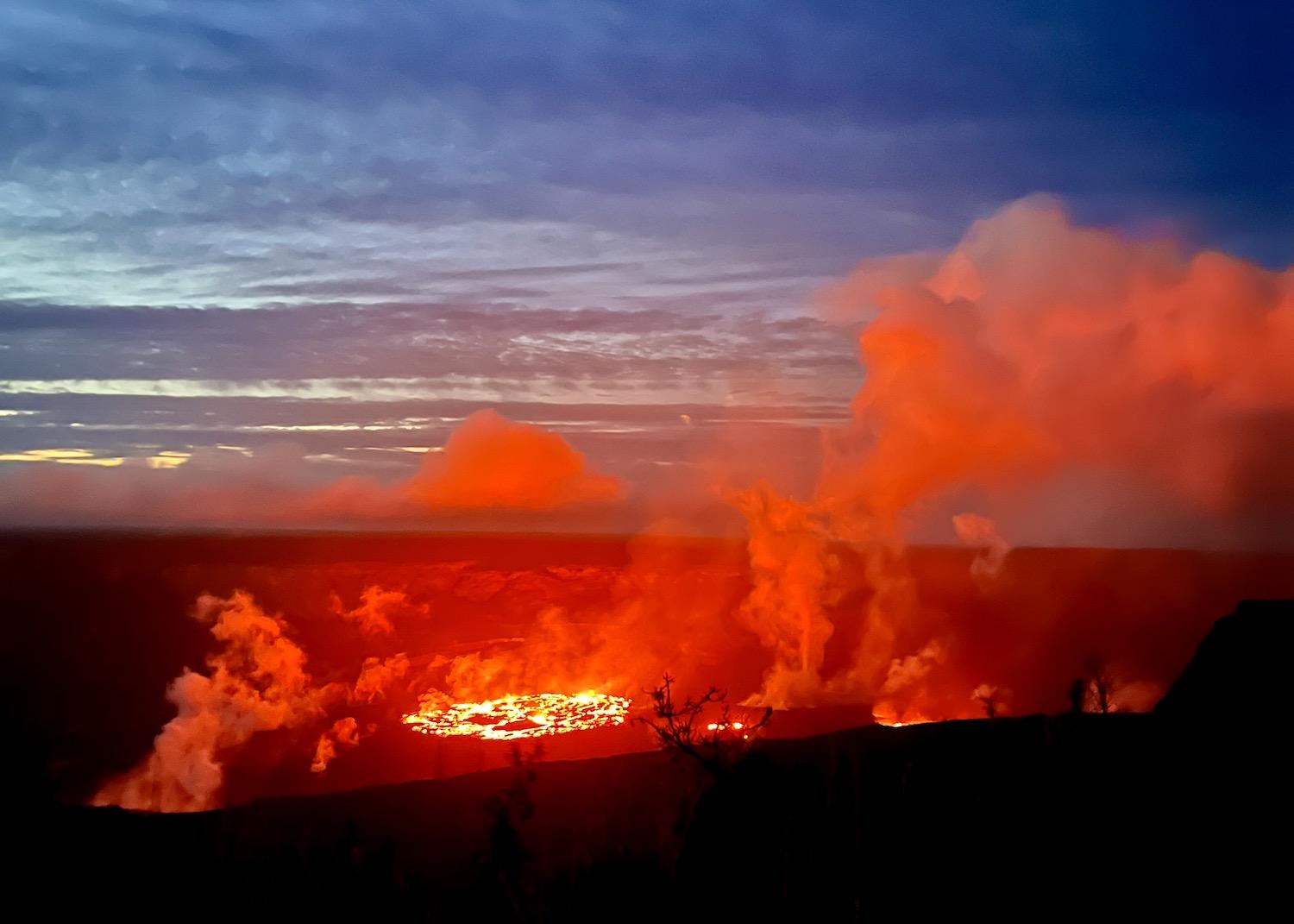
On Feb. 2, 2023, this was the view in Hawai'i Volcanoes National Park/Jennifer Bain
The sky glowed fierce shades of orange and red that night in February when I stood at the Kīlauea Overlook and watched one of the world’s most active volcanoes do its thing. I was grateful to have evaded the crowds that gather here in Hawaiʻi Volcanoes National Park at sunset but also secretly unnerved to be alone in unfamiliar territory just before midnight.
Peering down into Halemaʻumaʻu crater from behind a waist-level fence, I finally got a good look at the giant lava lake that had formed when Kīlauea started erupting at the start of the year. Streaks of molten lava etched intricate patterns across the crater floor. The lava pooled and bubbled in spots. Billowing steam clouds turned a hazy pinkish red from the glow of the lake and shape-shifted over the Kīlauea caldera.
Two sets of people arrived at the summit, making the one-minute walk from the parking lot to the overlook in silence and keeping a respectful distance from me. Nobody spoke. Not to each other. Not to me.

The view of the lava lake from the Kīlauea Overlook in February/Jennifer Bain
For 30 perfect minutes, I admired Kīlauea until I thought I had seen enough. But back at Kīlauea Lodge & Restaurant in Volcano Village, I was too fired up to sleep and so rose again at 4:30 a.m. to make the 10-minute drive in the dark to the summit for sunrise.
This time I stood mesmerized — with a hat and gloves to cope with the 50F chill — for nearly two hours as the darkness lifted, the vibrant volcanic colors muted and the rest of the caldera came into focus. This time, a boisterous crowd slowly gathered, jockeying for prime selfie space along the wall, taking copious photos and videos, striking up conversations with each other, and providing a running commentary for all to hear.
“When the sun comes up, it’s not as brilliant,” one man mused.
“Wow, this is insane,” someone else enthused.
“You don’t get to see that every day,” one woman said with admiration.
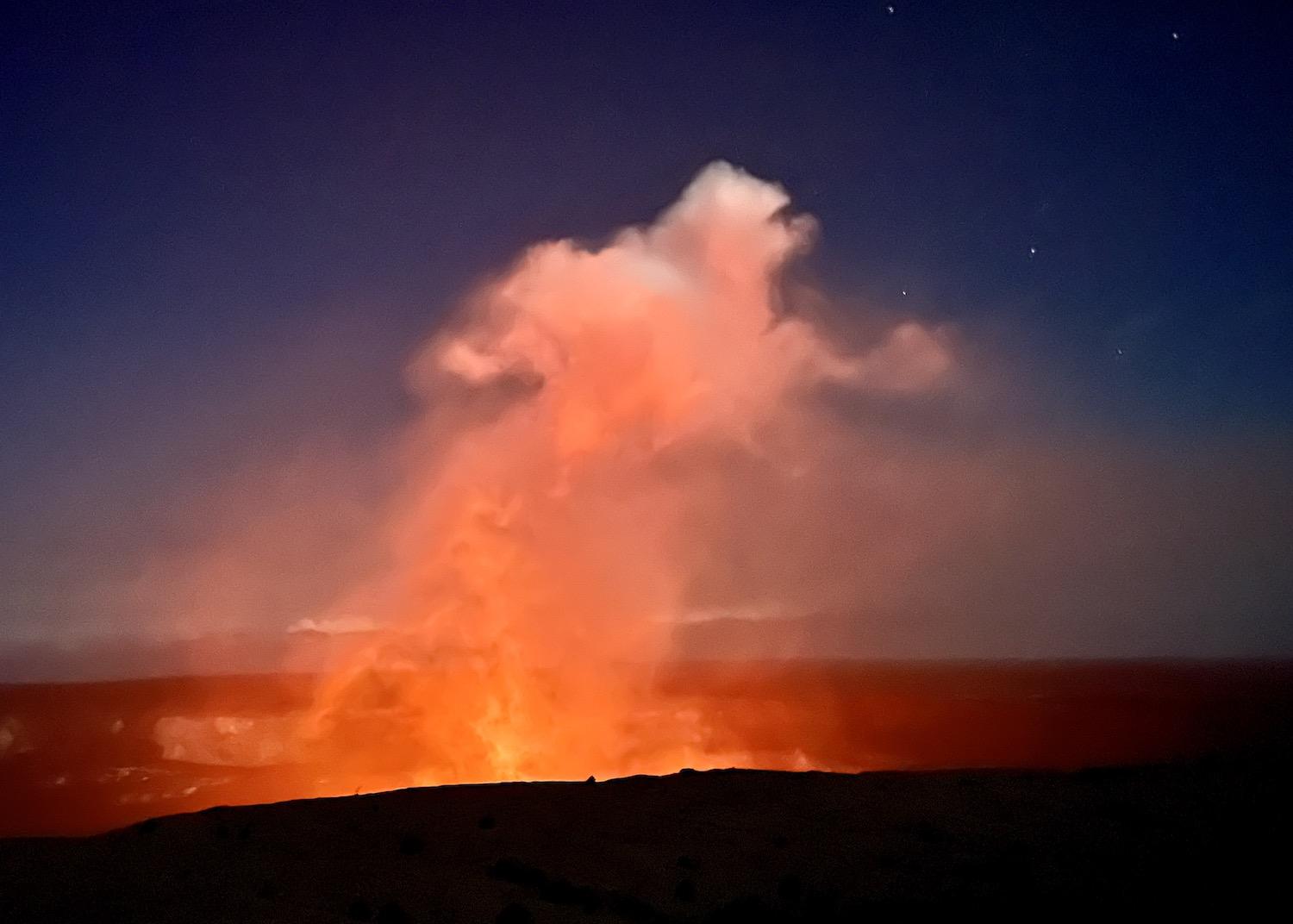
At dawn, this steam cloud over the Kīlauea Caldera looked almost human for a moment/Jennifer Bain
The sunrise crowd was small enough that the eavesdropping was entertaining and not annoying, and besides everyone seemed exuberant just to be there witnessing something so astounding. I considered returning for a third eruption viewing at sunset when you apparently can’t find a place to park and must contend with raucous strangers and bus groups. But I couldn’t bring myself to mar my summit memories, even just to satisfy my curiosity about the best and worst ways to experience an eruption.
Most people come to Hawaiʻi Island for the sun, sand and surf. Some also come for this national park and its volcanoes — Kīlauea and Maunaloa (the preferred local spelling is now one word). What I didn’t grasp when I planned the latter kind of trip from my home in Toronto was that volcanoes constantly change.
This means that what my friend Jennifer Allford experienced here in 2016 when she hiked a rather gruelling 12 miles with a guide to see lava flowing across the land into the ocean was not what the Traveler’s founder Kurt Repanshek witnessed in 2021 when he and his wife walked a mile to another popular viewing spot. It was less than 100 steps from the parking lot to my entirely different viewpoint.
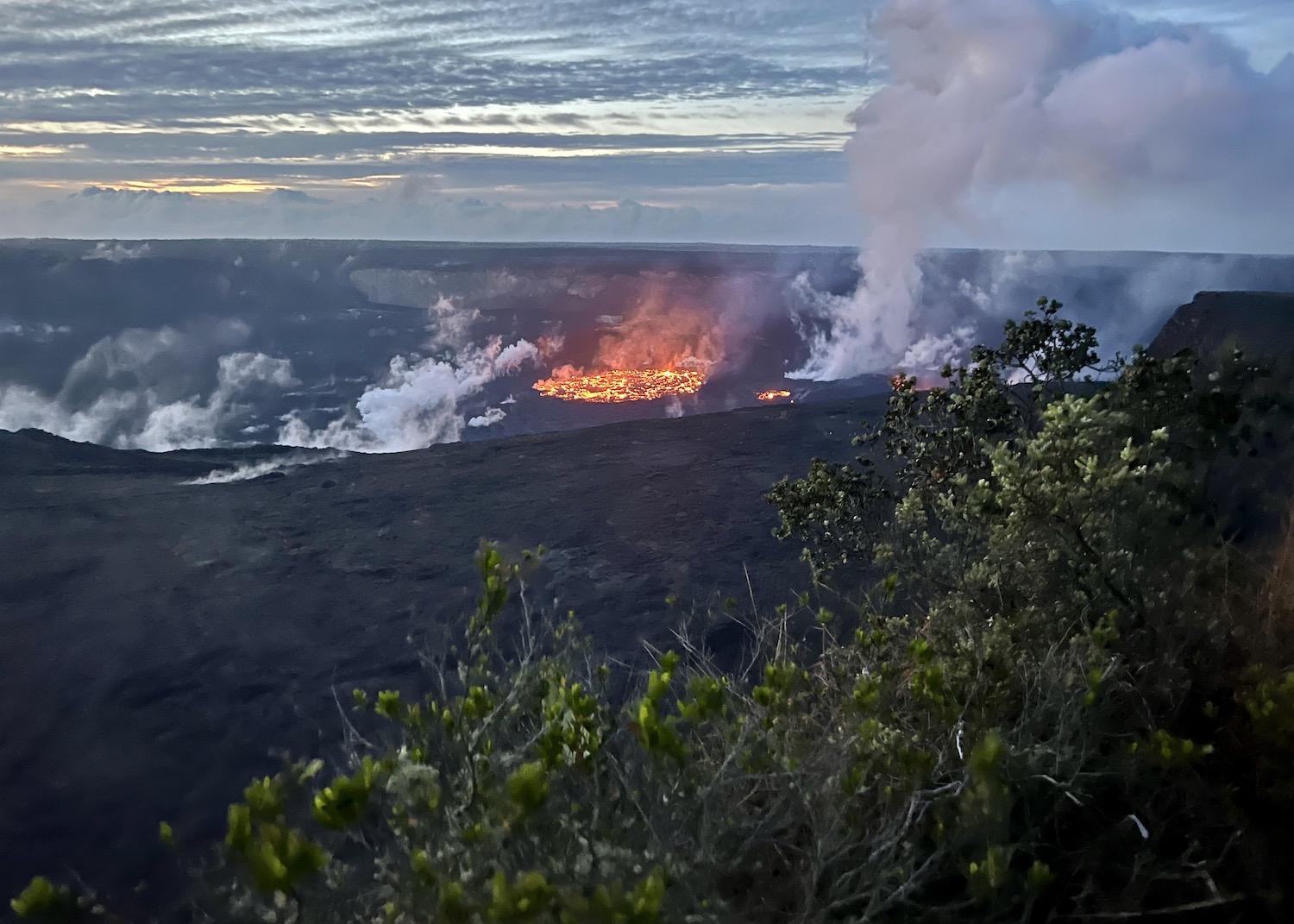
After sunrise, the eruption viewing becomes admittedly less exciting/Jennifer Bain
“It’s never the same day twice working in this park,” Jessica Ferracane, the park’s public affairs specialist, told me during a quick orientation.
Established in 1916, Hawaiʻi Volcanoes is a sprawling 354,461 acres and extends from sea level to 13,680 feet. While I didn't make it to the highest point, I did drive the length of Chain of Craters Road to Hōlei Sea Arch, a stark lava rock formation that juts into the Pacific Ocean. The park is a designated International Biosphere Reserve and UNESCO World Heritage Site, but its main job is to protect, study and provide access to Kīlauea and Maunaloa. Volcanic features include calderas, pit craters, cinder cones, spatter ramparts, fumaroles, solfataras, tree molds, black sand beaches and thermal areas. I don't know what all those things are, but I do know that Nāhuku (Thurston Lava Tube) is also best experienced at dawn before it gets crowded and hot.
Hawaiʻi Volcanoes is open 24/7. In 2021, it drew 1.26 million visitors.

Ranger Keoni Kaholoʻaʻā — a Native Hawaiian — gives a talk about volcanoes on a bluff overlooking Kīlauea Caldera/Jennifer Bain
“All we hear all day is `where do I go to see lava?’” ranger Keoni Kaholoʻaʻā said with a weary sigh during his “Life on the Edge” talk at Steaming Bluff (Wahinekapu) near the Steam Vents parking area. A "local boy of Hawaiian descent," he explained how Kīlauea is a sacred and cherished landscape.
He vouched for the night-time viewing from Kīlauea and Keanakākoʻi overlooks that week, but said the million-dollar question is always what time to come. “Well, I can tell you between 5 and 8:30 p.m. you might not want to be here because every lodi dodi let’s join the party is going to be here. It is what it is. But if you have the will to come after 9, or 10, or 11, 12, 1, 2, 3, or — in my opinion — 5:30 in the morning, there is no crowd. And many times, if you are out here by yourself, you can hear the lava lake at night slushing around. Sounds like jet engines. Sometimes it sounds like bombs.”
I regret being so caught up in watching Kīlauea, and taking photos, that I didn’t fully absorb what I was hearing. But when I played back a few cell phone videos, it does indeed sound like jet engines. On another sensory front, I will never forget how my eyes watered and my mouth dried out and tasted metallic. That's because noxious sulphur dioxide gas and other air pollutants from the volcano react with oxygen, atmospheric moisture and sunlight to produce volcanic smog (vog) and acid rain, which can be dangerous at times for people with respiratory and heart issues, infants, young children and pregnant women.
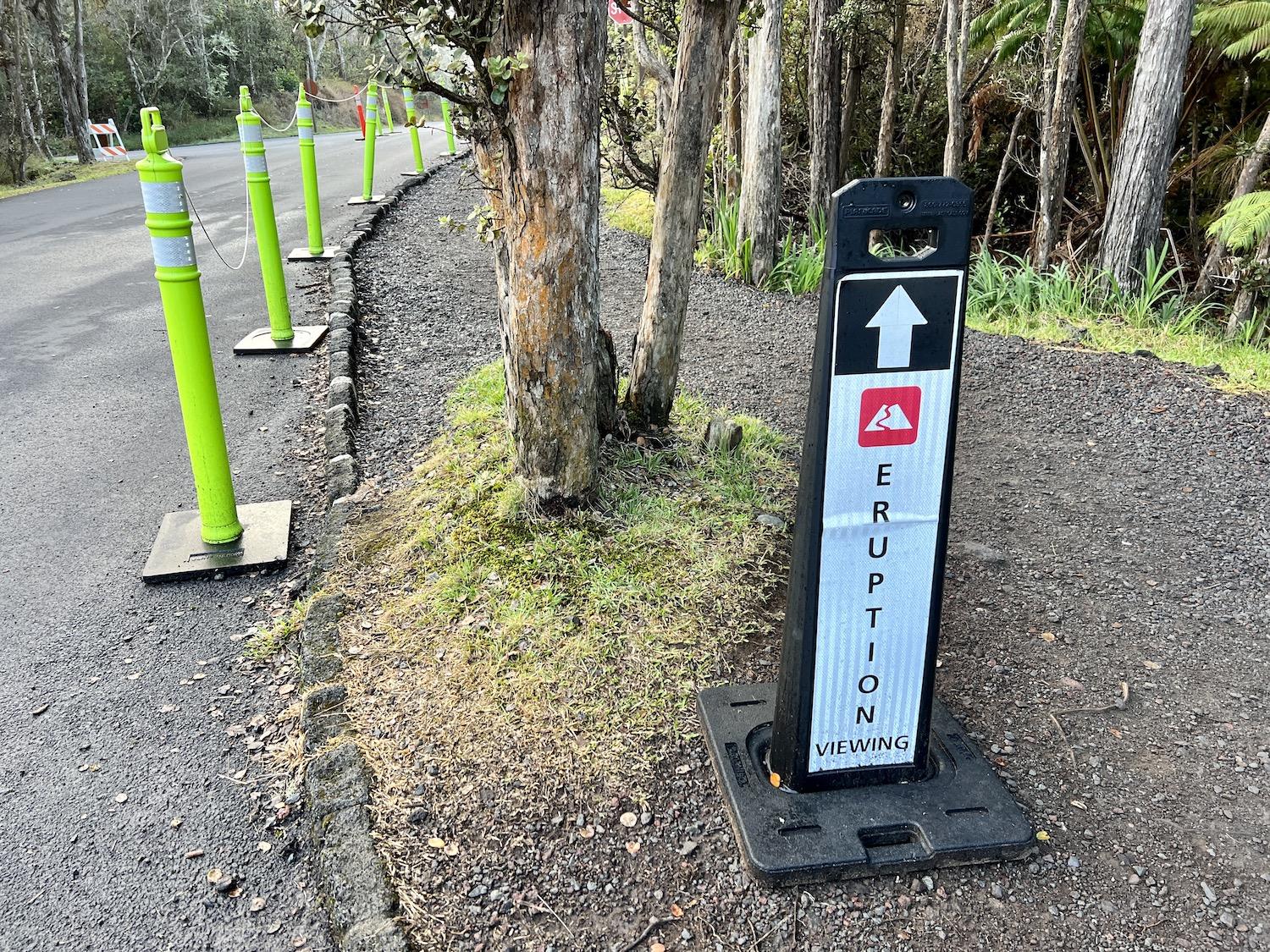
Helpful "eruption viewing" signs point park visitors in the right direction/Jennifer Bain
Kaholoʻaʻā rounded out his short talk by showing historical photos of crowds marvelling at eruptions over the years, and then explaining the cyclical motion and life cycle of this particular volcano. Three hundred years of explosive eruptions are usually followed by 300 years of calm eruptions, he said, warning that we're about 230 years into a calm phase.
“People have been drawn to this place because of the energy that an active volcano produces," Kaholoʻaʻā told us. "There’s a lot of metaphors that we as humans can relate to without even subconsciously thinking about. We have creation, we have birth, we have destruction, we have death — all things that we will all go through in our lifetimes. But if you come here with respect and reverence of this special place, you will be able to enjoy it.”

A trail from Volcano House goes down through this rainforest to the caldera floor/Jennifer Bain
And enjoy it I did, especially when I found myself alone once again a few hours after that sunrise viewing experience.
Ducking through the Volcano House hotel (with a side trip to its gift shop), I found Halema'uma'u Trail outside its back door and followed it down 425 feet through a lush rainforest to the floor of the Kīlauea Caldera. I had the trail to myself.
In an online trail guide, I read that many believe the caldera formed during an epic battle between Pelehonuamea (Pele), the Hawaiian volcano deity, and her younger sister Hi‘iaka over a lover and an ‘ōhi‘a forest. The short of it is that Pele buried her cheating lover beneath a flood of lava and when Hi‘iaka dug furiously to recover the body, she formed the great caldera of Kīlauea.
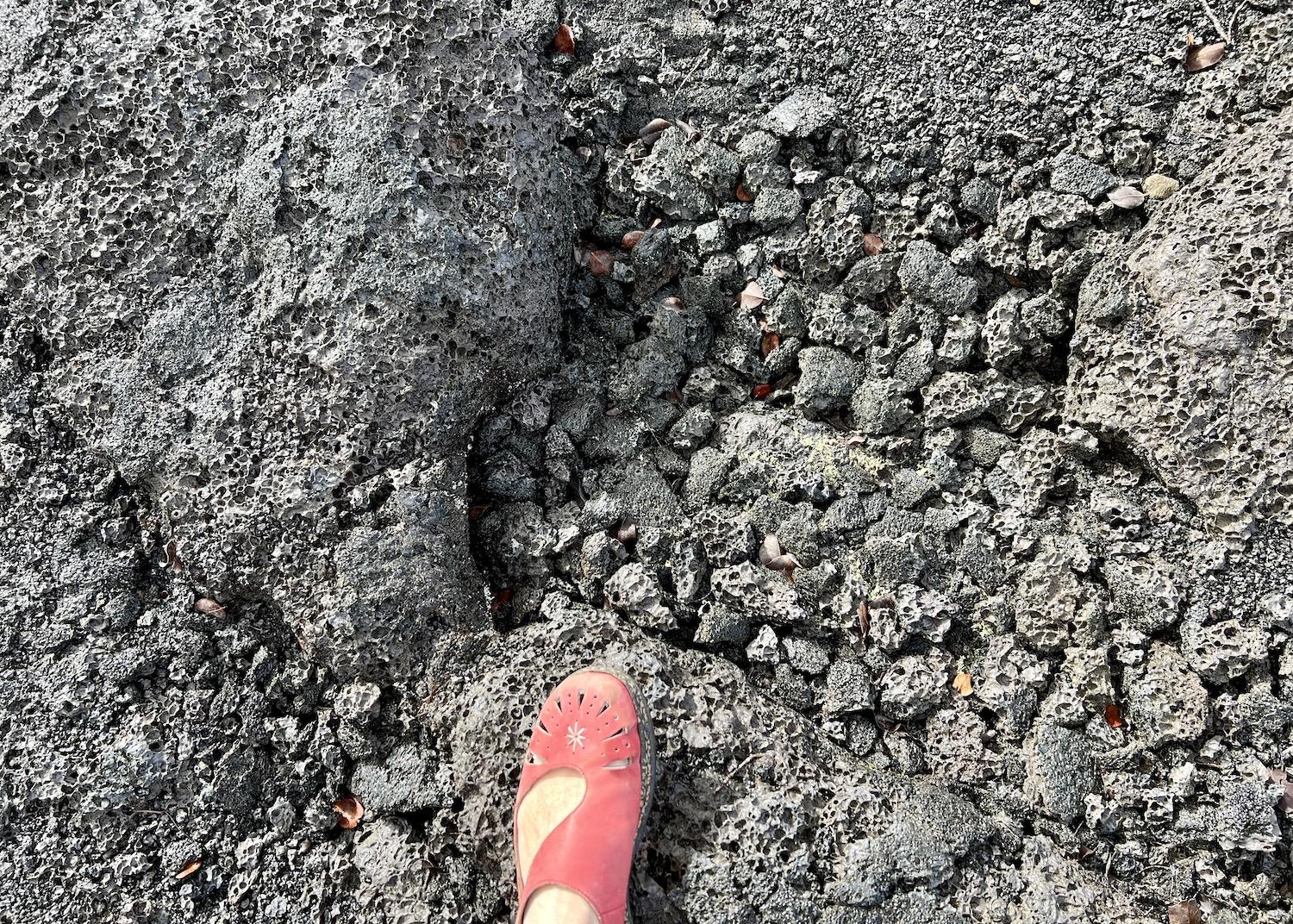
Beautiful but treacherous solidified lava on the caldera floor during a short hike/Jennifer Bain
From the caldera floor, I could just make out the lava lake area in the distance. By day, the steam clouds were white and no longer glowed orange. Ahu (stacked rocks) marked a short patch of trail that crossed a desolate, rocky landscape before heading back uphill through the forest. I kept my eyes on the uneven terrain as I gingerly stepped across solidified lava, mindful of steam vents, earth cracks and other natural dangers.
Less than a month later, sitting down to write about volcanoes, I kept thinking about all the icebergs that I've seen in Canada, how no two are alike, and how each one constantly changes until it melts and disappears. I struggled with how to convey the singular beauty of what I'd been blessed to witness in Hawaiʻi Volcanoes National Park but also gently warn that my experience couldn't be duplicated.
When I returned to the park's website, I found this update that perfectly captures the ephemeral nature of active volcanoes: "The Kīlauea volcano eruption paused on March 7th, 2023 after 61 days of volcanic activity. No lava or night-time glow are visible from at this time. Volcanic conditions can change at any time."

A path from Volcano House down Halema'uma'u Trail takes you out briefly along the caldera floor/Jennifer Bain

 Support Essential Coverage of Essential Places
Support Essential Coverage of Essential Places



